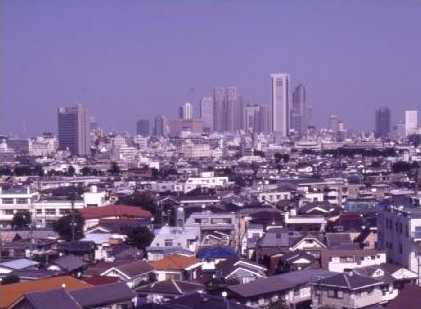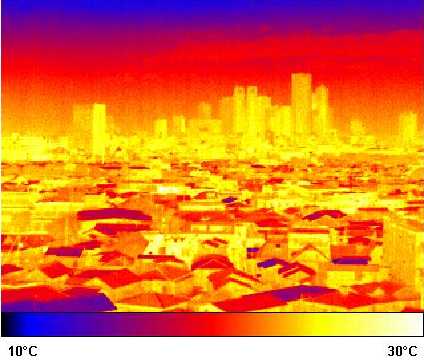|
|
|
|
Urban Climatology and Urban Thermal Climates An urban climatologist studies the climate in and around cities. Urban areas are both affected by weather and climate, and exert an influence on the local scale weather and climate. The climate in and around cities and other built up areas is altered in part due to modifications humans make to the surface of the Earth during urbanization. The surface is typically rougher and often drier in cities, as naturally vegetated surfaces are replaced by buildings and paved streets. Buildings along streets form urban street "canyons" that cause the urban surface to take on a distinctly three-dimensional character. These changes affect the absorption of solar radiation, the surface temperature, evaporation rates, storage of heat and the turbulence and wind climates of cities and can drastically alter the conditions of the near-surface atmosphere. Human activities in cities also produce emissions of heat, water vapour and pollutants that directly impact the temperature, humidity, visibility and air quality in the atmosphere above cities. On slightly larger scales, urbanization can also lead to changes in precipitation above and downwind of urban areas. In fact, urbanization alters just about every element of climate and weather in the atmosphere above the city, and sometimes downwind of the city. Although cities themselves form a very small fraction of the Earth's surface area, the world's population has become increasingly urbanized and is now affected by urban climates. Cities too, are important sites for greenhouse gas emissions because of the high energy demands by urban residents and activities. These emissions extend the (indirect) influence of cities on climate to much larger scales. Locally altered urban climates that have existed for many years may provide us with some insight into how to respond to large scale climate change and this makes the study of urban climates increasingly important. Urban climatologists study a range of problems. Some urban climatologists specialize in understanding atmospheric processes, and therefore use knowledge and techniques from the fields of geography, meteorology, chemistry, physics and biology to study problems such as air pollution, turbulence, precipitation effects, urban heat islands, and representing urban areas in numerical models. Others study more applied problems such as: urban climate and the health of city inhabitants, the use of greenspace and vegetation to improve urban climates, urban climate and urban planning, or the use of remote sensing to observe urban climates. Figure 1. The author (left photograph) preparing instruments for an urban climate study in Tokyo, Japan. The
right-hand photograph shows the extended tower with the skyline of the Shinjuku area of Tokyo in the background. Photographs courtesy of M. Roth (National University of Singapore). My own research focuses on urban surface temperatures. The surface temperature is an important quantity that plays a role in many environmental processes. The surface temperature is a measure of the state of energy exchange at the surface and therefore combines the influences of a number of processes that occur at the surface such as radiative exchange, subsurface heat storage, evaporation and turbulent heat fluxes. The importance of the surface temperature to urban climates means that accurate observations of surface temperature can provide much information about the surface climate. However, the complexity of urban surfaces means that it is exceedingly difficult to obtain representative measurements of surface temperature because of the number of surfaces that need to be sampled. To get around this problem, researchers often make remote measurements of surface temperature using instruments called radiometers that measure the radiation coming from the surface. These instruments may be mounted on satellites (often used to make images of clouds for weather forecasting), aircraft, tall towers, or on the ground. These instruments are able to provide images of the surface temperature, when corrections are made for atmospheric effects on the transmission of radiation to the instrument and on the reflectivity of the surface for radiation. The use of radiometers to measure the surface temperature of urban areas or other land surfaces that have a three-dimensional surface structure poses an additional difficulty: like a normal camera, a radiometer can only "see" those parts of the surface in direct line of sight. When looking in different directions, different portions of the surface are viewed, and this means that the measurement of the surface temperature will change with the viewing direction. My research is related to understanding these effects over cities through observation and modelling and developing techniques that will allow us to make more representative temperature measurements over cities and other three-dimensionally rough surfaces. I also am interested in the use of urban surface temperatures as they relate to: the assessment of urban heat islands using satellite and aircraft sensors, how the surface temperature influences the air temperature in urban areas, modelling of heat fluxes from urban surfaces using observations of surface and air temperatures, and planning urban areas to consider the impacts of surface temperatures on the local climates that affect residents. For my work, I need a range of capabilities associated with studying urban surfaces, as well as an overall perspective on the urban environment. Studies in Geography have provided me with both knowledge regarding Earth surface environments and an introduction to techniques such as remote sensing and Geographic Information Systems. Figure 2. Photograph (left) and thermal image (right) of a dense residential neighbourhood in Tokyo Japan. The skyline of the Shinjuku area of Tokyo is visible in the background. The thermal image was taken in early October during the late afternoon as the urban surface began to cool. The photograph was taken on a different day and is courtesy of M. Roth (National University of Singapore).   |